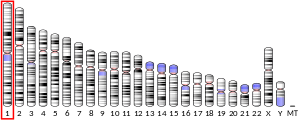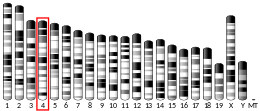TNFRSF18
Tumor necrosis factor receptor superfamily member 18 (TNFRSF18) also known as activation-inducible TNFR family receptor (AITR)[5] or glucocorticoid-induced TNFR-related protein (GITR) is a protein that in humans is encoded by the TNFRSF18 gene.[6][7][8] GITR is currently of interest to immunologists as a co-stimulatory immune checkpoint molecule.
Function
TNFRSF18 is a member of the tumor necrosis factor receptor (TNF-R) superfamily. This receptor has been shown to have increased expression upon T-cell activation, and it is thought to play a key role in dominant immunological self-tolerance maintained by CD25+/CD4+ regulatory T cells. Knockout studies in mice also suggest the role of this receptor is in the regulation of CD3-driven T-cell activation and programmed cell death. Three alternatively spliced transcript variants of this gene encoding distinct isoforms have been reported.[8]
AITR
Human activation-inducible tumor necrosis factor receptor (AITR) and its ligand, AITRL, are important costimulatory molecules in the pathogenesis of autoimmune diseases. Despite the importance of these costimulatory molecules in autoimmune disease, their role in the autoimmune reaction to herniated disc fragments has yet to be explored.[9]
GITR
GITR was identified as a new member of the TNF receptor superfamily, by comparing gene expression in untreated and DEX-treated murine T-cell lines. GITR can also be induced when T cells are activated. Although mouse GITR is induced by either GC engagement or T-cell activation, its human homologue (hGITR/AITR) is upregulated only by activation. Therefore, the requirements for GR signaling in inducing GITR expression by T cells remain moot .[10]
GITR (glucocorticoid-induced tumor necrosis factor receptor) is a surface receptor molecule that has been shown to be involved in inhibiting the suppressive activity of T-regulatory cells and extending the survival of T-effector cells. In mouse models, GITR was initially noted to be selectively enriched on the surface of regulatory T cells, making this an attractive potential surface marker for these rare cells. However, subsequent studies revealed GITR to also be up-regulated on any activated T cells in humans, thus undermining its utility as a regulatory T cell marker.[11]
References
- GRCh38: Ensembl release 89: ENSG00000186891 - Ensembl, May 2017
- GRCm38: Ensembl release 89: ENSMUSG00000041954 - Ensembl, May 2017
- "Human PubMed Reference:". National Center for Biotechnology Information, U.S. National Library of Medicine.
- "Mouse PubMed Reference:". National Center for Biotechnology Information, U.S. National Library of Medicine.
- Kim YS, Jung HW, Choi J, Kwon BS, Ham SY, Jung AK, Ko BK (Nov 2007). "Expression of AITR and AITR ligand in breast cancer patients". Oncol Rep. 18 (5): 1189–94. doi:10.3892/or.18.5.1189. PMID 17914571.
- Nocentini G, Giunchi L, Ronchetti S, Krausz LT, Bartoli A, Moraca R, Migliorati G, Riccardi C (Jul 1997). "A new member of the tumor necrosis factor/nerve growth factor receptor family inhibits T cell receptor-induced apoptosis". Proc Natl Acad Sci U S A. 94 (12): 6216–21. Bibcode:1997PNAS...94.6216N. doi:10.1073/pnas.94.12.6216. PMC 21029. PMID 9177197.
- Kwon B, Yu KY, Ni J, Yu GL, Jang IK, Kim YJ, Xing L, Liu D, Wang SX, Kwon BS (Mar 1999). "Identification of a novel activation-inducible protein of the tumor necrosis factor receptor superfamily and its ligand". J Biol Chem. 274 (10): 6056–61. doi:10.1074/jbc.274.10.6056. PMID 10037686.
- "Entrez Gene: TNFRSF18 tumor necrosis factor receptor superfamily, member 18".
- Park MS, Lee HM, Hahn SB, Moon SH, Kim YT, Lee CS, Jung HW, Kwon BS, Riew KD (Oct 2007). "The Association of the Activation-Inducible Tumor Necrosis Factor Receptor and Ligand with Lumbar Disc Herniation". Yonsei Med J. 48 (5): 839–46. doi:10.3349/ymj.2007.48.5.839. PMC 2628152. PMID 17963343.
- Yifan Zhan; David P. Funda; Alison L. Every; Petra Fundova; Jared F. Purton; Douglas R. Liddicoat; Timothy J. Cole; Dale I. Godfrey; Jamie L. Brady; Stuart I. Mannering; Leonard C. Harrison; Andrew M. Lew (2004). "TCR-mediated activation promotes GITR upregulation in T cells and resistance to glucocorticoid-induced death". International Immunology. 16 (9): 1315–1321. doi:10.1093/intimm/dxh134. PMID 15262900.
- Shimizu J, Yamazaki S, Takahashi T, Ishida Y, Sakaguchi S (February 2002). "Stimulation of CD25(+)CD4(+) regulatory T cells through GITR breaks immunological self-tolerance". Nat. Immunol. 3 (2): 135–42. doi:10.1038/ni759. PMID 11812990.
Further reading
- Gurney AL, Marsters SA, Huang RM, et al. (1999). "Identification of a new member of the tumor necrosis factor family and its receptor, a human ortholog of mouse GITR". Curr. Biol. 9 (4): 215–8. doi:10.1016/S0960-9822(99)80093-1. PMID 10074428.
- Nocentini G, Ronchetti S, Bartoli A, et al. (2000). "Identification of three novel mRNA splice variants of GITR". Cell Death Differ. 7 (4): 408–10. doi:10.1038/sj.cdd.4400670. PMID 10836847.
- McHugh RS, Whitters MJ, Piccirillo CA, et al. (2002). "CD4(+)CD25(+) immunoregulatory T cells: gene expression analysis reveals a functional role for the glucocorticoid-induced TNF receptor". Immunity. 16 (2): 311–23. doi:10.1016/S1074-7613(02)00280-7. PMID 11869690.
- Ronchetti S, Nocentini G, Riccardi C, Pandolfi PP (2002). "Role of GITR in activation response of T lymphocytes". Blood. 100 (1): 350–2. doi:10.1182/blood-2001-12-0276. PMID 12070049.
- Clark HF, Gurney AL, Abaya E, et al. (2003). "The Secreted Protein Discovery Initiative (SPDI), a Large-Scale Effort to Identify Novel Human Secreted and Transmembrane Proteins: A Bioinformatics Assessment". Genome Res. 13 (10): 2265–70. doi:10.1101/gr.1293003. PMC 403697. PMID 12975309.
- Zhang Z, Henzel WJ (2005). "Signal peptide prediction based on analysis of experimentally verified cleavage sites". Protein Sci. 13 (10): 2819–24. doi:10.1110/ps.04682504. PMC 2286551. PMID 15340161.
- Esparza EM, Arch RH (2005). "Glucocorticoid-induced TNF receptor, a costimulatory receptor on naive and activated T cells, uses TNF receptor-associated factor 2 in a novel fashion as an inhibitor of NF-kappa B activation". J. Immunol. 174 (12): 7875–82. doi:10.4049/jimmunol.174.12.7875. PMID 15944293.
- Baumgartner-Nielsen J, Vestergaard C, Thestrup-Pedersen K, et al. (2006). "Glucocorticoid-induced tumour necrosis factor receptor (GITR) and its ligand (GITRL) in atopic dermatitis". Acta Derm. Venereol. 86 (5): 393–8. doi:10.2340/00015555-0118. PMID 16955181.
- Baltz KM, Krusch M, Bringmann A, et al. (2007). "Cancer immunoediting by GITR (glucocorticoid-induced TNF-related protein) ligand in humans: NK cell/tumor cell interactions". FASEB J. 21 (10): 2442–54. doi:10.1096/fj.06-7724com. PMID 17360848.
- Lahey TP, Loisel SD, Wieland-Alter W (2007). "Glucocorticoid-Induced Tumor Necrosis Factor Receptor Family–Related Protein Triggering Enhances HIV-Specific CD4+ T Cell Cytokine Secretion and Protects HIV-Specific CD4+ T Cells from Apoptosis". J. Infect. Dis. 196 (1): 43–9. doi:10.1086/518613. PMC 2872147. PMID 17538882.
- Coe D, Begom S, Addey C, White M, Dyson J, Chai JG (2010). "Depletion of regulatory T cells by anti-GITR mAb as a novel mechanism for cancer immunotherapy". Cancer Immunol. Immunother. 59 (9): 1367–77. doi:10.1007/s00262-010-0866-5. PMID 20480365.
This article incorporates text from the United States National Library of Medicine, which is in the public domain.



